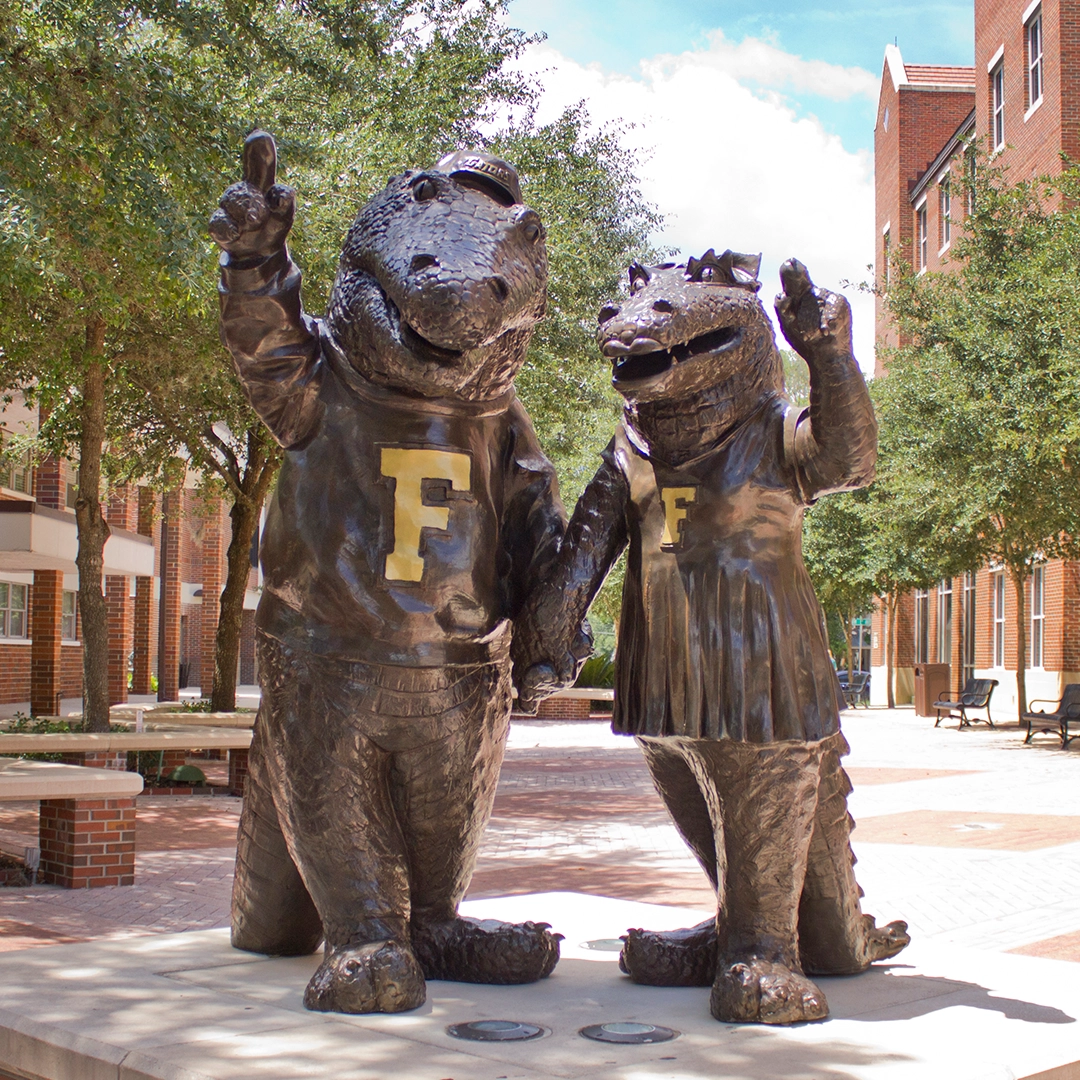by Jessica Giles | March 8, 2021
Running Down A Dream: 5 Athletes Tackle the Donna Marathon in a Pandemic
From adaptive athletes to breast cancer survivors, these five marathon racers are inspiring us to lace up for a good cause.

Mention “the Donna” to any Jacksonville local and there’s no explanation necessary. The annual marathon held to raise money for breast cancer patients and research is the only one of its kind in the nation and has become an iconic event for the city, whether you’re a runner or not.
Every February, about 10,000 people flock to Jacksonville Beach in their pinkest, frilliest, wackiest attire to raise money for the Donna Foundation, created by three-time breast cancer survivor and recent congressional candidate Donna Deegan. The foundation offers financial support to breast cancer patients and their families during treatment as well as funding groundbreaking research to fight the disease. In a typical year, the course also serves as a qualifying race for runners with their sights set on the Boston Marathon.
But COVID-19 rendered 2020 anything but a typical year and caused every major race from the New York City Marathon to the Boston Marathon to be canceled or go virtual. The Donna Foundation opted for the virtual route in 2021. Each year the Donna Marathon and its fundraisers aim to raise $500,000 for the foundation, and it was more important than ever this year considering that the foundation received nearly double the number of requests for assistance in 2020 than in 2019, Deegan says. At the time of this publication, the foundation has raised just over $400,000.
“The reason obviously is because of COVID there are so many people who have lost their jobs, and so many people have lost their healthcare,” she says. “Those people are struggling to pay their bills while they’re going through their treatment, and some people are making crazy choices between food and medicine.”
Although participants mourned the loss of the physical race this year, thousands of people still showed up virtually for the cause. Participants had the choice to run all their miles at once between Feb. 6 and Feb. 14 for an official time or spread their miles out over several days. To chronicle their stories, Flamingo joined them (also virtually) on their journeys. Here are the stories of five athletes who laced up and logged miles for those who couldn’t.
Mile 1: The Hope of a Starting Line

There’s something about a starting line that infuses Deegan with joy. At the inaugural Donna Marathon in 2008, the energy radiating from the 7,000 people who came out to join the cause made Deegan believe anything was possible.
She wasn’t supposed to run all 26.2 miles that snake alongside the coast of Jacksonville through Ponte Vedra Beach, Atlantic Beach and Neptune Beach. The two-time breast cancer survivor had learned just three months earlier that the cancer had come back.
“I received the diagnosis that the cancer had gone to my left lung,” she says. “And so I had to have surgery to take out a portion of my lung and more chemotherapy.”
Given her diagnosis, Deegan, now 60, only planned to run the first six miles, and then tag in her husband, doctor and other team members to relay to the finish line. But there was something about that starting line.

“I just turned to my doctor, and I said, ‘What would happen if I ran the whole way?’” she recalls. “So long story short, I ran the entire marathon just doped up on joy, basically.”
Even without all the pink confetti, crowds, tutus and wigs this year, Deegan still felt that joy welling up inside her as she laced up her sneakers. She’s normally a black leggings and Donna T-shirt kind of girl, but this year, the founder went all out, donning tights covered in hearts, a “Love Over Fear” shirt and a bright red jacket, while her husband, Tim, pulled on a multicolored skirt. On Valentine’s Day morning, they set out for the Beaches Town Center. Part of it was muscle memory and part of her was hoping she’d see some familiar faces.
In a normal year, this is where thousands of people would congregate at the starting line, waving signs like, “You’re running for my mother,” sporting shirts saying “Two-time Survivor” and clanging cowbells. This year, it was an eerily quiet Sunday morning, too early for the restaurants to be open or the sun to be up. A pang of sadness for what was missing was quickly replaced with surprise as Deegan bumped into Donna runner after Donna runner.
“It was fun to see so many people out and so many yards decorated,” she says. “It made you really miss the big crowd but at the same time it was fun to see other people out getting it done. I think it’s sort of a testament to resiliency.”
It wasn’t just Atlantic Beach locals she saw out on the course, she saw participants from Virginia and California who flew in just so they could clock their Donna miles in Jacksonville. Despite going virtual, the marathon still had all 50 states and several countries represented.
“I think that it made all of us realize that our mission and our purpose is just so much bigger than we are,” Deegan says.
Mile 5: For Those Who Can’t

Lorraine Hardaway has been running the Donna marathon since the inaugural race, but this year felt a little bittersweet.
Not just because the race had gone virtual, but because she found herself running for the same woman she dedicated her miles to back in 2008. Her friend and coworker at a local running store in Orlando was diagnosed with breast cancer that year, and coincidentally, shares the name “Donna.” Hardaway participated in the first Donna Marathon in her honor. Now, more than a decade later, her friend is battling metastatic breast cancer.
“She has been an inspiration to all of us because she’s hung in there so hard,” Hardaway says.
Over the years, Hardaway, 64, has become an ambassador for the Donna Marathon, organizing local events in her hometown and pulling together a group to run each year. She even decided to ramp up her commitment this year by registering for the Donna’s ultramarathon—110 miles run all at once or throughout the month.

As if that wasn’t enough, she also organized a small Donna event in Orlando for the local runners who usually make the drive to Jacksonville.
At mile five, Hardaway and her friends couldn’t help but swap stories about their Donna, her resilience and how she cultivated the running community in Orlando. There was nothing more fitting than completing a half-marathon in her honor, especially now as the cancer has made her once-beloved activity an impossibility.
“I’m just so happy to be out there for a cause for other women who literally cannot do it,” she says. “I’m not world-class fast. I don’t win any races, but I can run 110 miles in the month of February, and feel great. So I’m so grateful.”
Mile 10: Powered by Survivors

Meaghan was sure she misheard them. She hadn’t been looking at her watch, instead opting to let her four pacers worry about the distance, but she’d still been mentally ticking off the miles as she completed her loops around the lake. When they called out mile 10, she was caught off guard. She could’ve sworn she was only on mile 9. Some things you just don’t question.
For her four pacers, the speed was nothing, but Meaghan Neuberger was giving it her all. She had a streak to uphold.
The 33-year-old Baltimore native had claimed first place in the women’s Donna Marathon for four years running, and this year, she had her sights set on the half-marathon gold. Typically she’d be racing toward the finish line in sunny Jacksonville surrounded by runners and survivors and spectators cheering her on. This year, she was striving for a Donna personal record in her hometown of Baltimore, where it was 34 degrees with a “feels-like” temperature of 28. “Not horrible,” she says.

What worried her more than the freezing temperature were her ambitious pacers. To hit her personal best, Neuberger was aiming for a pace of 6 minutes and 22 seconds per mile. But as they called out her average pace and the miles trekked on, her anxiety rose. Six minutes and 18 seconds. Six minutes and 15 seconds.
“I’m either going to blow up at mile 10 or I’m going to have a really good run,” she thought.
The year of her inaugural win, Neuberger credited her spectacular performance to the environment. At mile 21, her calves started to cramp, and she began to wonder if she’d cross the finish line at all. Looking up and seeing all the survivors lining the course drove her forward.
“It’s hard to put into words how inspiring it is to be out there,” she says. “I’m 100 percent sure that’s the reason that kept me going.”
There may not have been a crowd of onlookers waving flags and tossing confetti on her this year, but she still had a survivor spurring her on.
Neuberger’s mother was diagnosed with breast cancer in 2014.
“She’s such a strong person, and she never wants to show any weakness. So I didn’t even really know that she was diagnosed until almost after her surgery,” Neuberger says.
It’s hard to put into words how inspiring it is to be out there.
— Meaghan Neuberger
Her mother has been in remission since her surgery in 2015, the same year she serendipitously met Deegan at a luncheon. Her strength serves as a reminder that Neuberger is capable of tackling hard things, like holding a pace that feels way too fast.
In fact, Neuberger didn’t blow up at mile 10, and she didn’t have a good run. She had a great run. A three-minute personal record run. Oh, and she kept her winning streak.
Mile 13: One in Eight Women
In some ways, Andi Sharp knew too much. As an emergency medicine physician at Mayo Clinic in Jacksonville, Sharp is skilled at diagnosing, treating and caring for her patients. But being the patient herself was unfamiliar territory.

In February of 2015, Sharp, now 47, ran her first marathon at the Donna in honor of a nurse at Mayo who had just been diagnosed with breast cancer. Two months later, Sharp received the same diagnosis.
“I just felt really blessed to have an early diagnosis, to have resources to treatments, to really know that I was going to be okay,” she says.
While Sharp was fortunate enough to detect the cancer early, she couldn’t shake the fact that so many women aren’t as lucky. To represent the one in eight women who develop breast cancer in a lifetime, Sharp set eight fitness goals she aimed to complete that year. Six weeks after she finished her radiation, Sharp ran a half-marathon. Then the Donna Marathon again. Then a half-Ironman.
For me, I was healthy and had no risk factors, so I think it shocked a lot of people, and I think it also made them realize ‘one in eight women’ is pretty powerful.
— Andi Sharp
And she didn’t tackle these goals alone. The year after her diagnosis, about 50 of her friends who had supported her throughout treatment ran alongside her at the Donna Marathon. They called themselves the Bouncy HuntERs. What began as a group of friends and coworkers running for Sharp has evolved over the years into a group about 100 strong running for every woman facing breast cancer.
“For me, I was healthy and had no risk factors, so I think it shocked a lot of people,” she says. “And I think it also made them realize ‘one in eight women’ is pretty powerful.”
Mile 20: Rainy Day Richard
Richard Solze doesn’t like to admit it, but his legs were getting tired. Up until now, the most consecutive miles the 63-year-old Army and Marines veteran had logged on his recumbent bike was 17. Mile 20 brought challenges he hadn’t encountered before.
“My lungs felt great,” Solze remembers. “My lungs could go the distance, but my legs got heavy on the way back.”
The Jacksonville local was racing alongside his fellow Brooks Adaptive Sports and Recreation athletes, a crew of individuals with physical, cognitive and visual disabilities that participate in free physical activities through the Brooks program. For Solze, it’s chronic pain he earned from his military service and some hard landings as a parachutist. Instead of giving up his active lifestyle, he took up the recumbent bike, which was much easier on his hips, back and neck.
While his military days might be behind him, Solze says some things never leave the blood.
This car may run out of gas.
— Richard Solze
“Yeah, I’m a competitive person,” he says. “The 36-and-a-half years I spent in the military wouldn’t allow me to be noncompetitive.”
So while Solze might have trained at a nice and easy pace, race day called for speed. Solze was worried he fell into a trap that so many athletes succumb to on race day: going out too fast. As he watched the miles roll by beneath his wheels, he began to worry. “This car may run out of gas,” he laughs.
It wasn’t just his innate need to compete that drove him to push harder than he normally would, he was also racing the rain.
Solze had been compulsively checking the weather since Tuesday. Each day it seemed to creep up: 30 percent chance of rain, then 60 percent, then 90. He emailed the program coordinators to inquire about the plan. The night before Feb. 13, Solze was convinced the race wouldn’t even happen. He showed up the morning of and tracked the hourly forecast. When the group’s start time was delayed 25 minutes, Solze was sure that meant 25 minutes of rain-soaked racing. He feared they may even need to evacuate halfway through.
So Solze pushed hard. He knew he needed to finish by 11 a.m. if he wanted to beat the storm, so he ignored the sandbags it felt like someone had tied to his legs and the unfamiliar mileage. When he crossed the finish line, relieved he had outraced Mother Nature, he turned to congratulate a fellow participant.
“Man, I had to put on my poncho when it started raining,” the other racer said. Solze paused.
“Huh, I don’t remember any rain,” Solze said.





